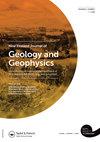新西兰奥特亚南岛/特威普纳穆西南边缘的海底麻点
IF 1.9
4区 地球科学
Q1 GEOLOGY
New Zealand Journal of Geology and Geophysics
Pub Date : 2022-01-12
DOI:10.1080/00288306.2021.2011328
引用次数: 2
摘要
封闭凹陷被称为麻坑,是一种广泛存在的海底形态,通常与流体渗流有关。本研究首次详细记录了新西兰奥特罗阿南岛/威普纳姆岛南韦斯特兰边缘的麻坑。在100-2600米的水深范围内,通过人工和半自动选择,通过多波束测深(25米网格)识别麻点。麻坑主要集中在海底峡谷之间400-850米水深的大陆斜坡区域。麻坑形态的连续体包括:(1)在部分填满的河道上方有较大(面积约0.5 km2)且形状不规则的麻坑;(2)小而圆的麻坑(直径约100-200米);~ 0.008-0.03 km2面积)发生在峡谷之间;(3)长形和中等大小的麻坑,一般沿坡向,常出现在埋藏泥沙波上方。细长的麻坑似乎被近海底的海洋学和/或浊流所改变。麻坑特征出现在奥特罗阿周围的许多地方,包括东部和西部边缘。在这些不同的构造、沉积和海洋环境中发现了一些相似的麻子形态,这表明它们的形成机制可能有一些相似之处,但导致它们形成的明确机制仍然是一个谜。本文章由计算机程序翻译,如有差异,请以英文原文为准。
Seafloor pockmarks on the South Westland margin of the South Island/Te Waipounamu, Aotearoa New Zealand
ABSTRACT Enclosed depressions, termed pockmarks, are widespread seafloor morphologies, commonly associated with fluid seepage. This study provides the first detailed documentation of pockmarks offshore the South Westland margin of the South Island/Te Waipounamu, Aotearoa New Zealand. Pockmarks are identified from multibeam bathymetry (25-m grid) through manual and semi-automated selection in water depths of 100–2600 m. Pockmarks are most concentrated at 400–850 m water depth on continental slope areas between submarine canyons. A continuum of pockmark morphologies includes – (1) large (>0.5 km2 area) and irregularly shaped pockmarks above partially infilled channels; (2) small and circular pockmarks (∼100–200 m diameter; ∼0.008–0.03 km2 area) occurring between canyons; and (3) elongated and intermediate size pockmarks, generally oriented along-slope and often occurring above buried sediment waves. Elongated pockmarks appear to have been modified by near-seafloor oceanographic and/or turbidity current flows. Pockmark features occur across many locations around Aotearoa, including both the eastern and western margins. Some similar pockmark morphologies are identified in these different tectonic, sedimentary, and oceanographic settings, suggesting that there may be some similarity in formative mechanisms, but clear mechanisms leading to their formation remain enigmatic.
求助全文
通过发布文献求助,成功后即可免费获取论文全文。
去求助
来源期刊
CiteScore
5.10
自引率
27.30%
发文量
34
审稿时长
>12 weeks
期刊介绍:
Aims: New Zealand is well respected for its growing research activity in the geosciences, particularly in circum-Pacific earth science. The New Zealand Journal of Geology and Geophysics plays an important role in disseminating field-based, experimental, and theoretical research to geoscientists with interests both within and beyond the circum-Pacific. Scope of submissions: The New Zealand Journal of Geology and Geophysics publishes original research papers, review papers, short communications and letters. We welcome submissions on all aspects of the earth sciences relevant to New Zealand, the Pacific Rim, and Antarctica. The subject matter includes geology, geophysics, physical geography and pedology.

 求助内容:
求助内容: 应助结果提醒方式:
应助结果提醒方式:


